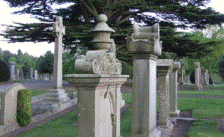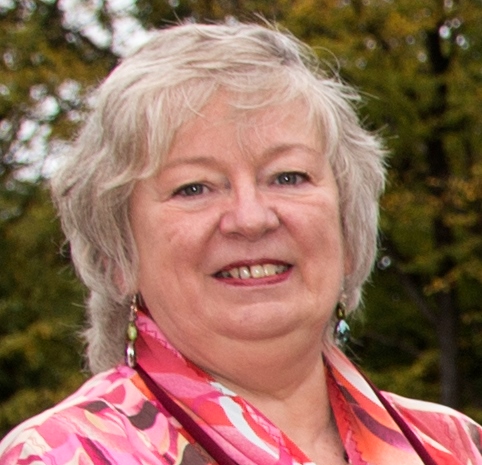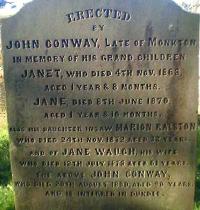- Birth*: Jane Conway was born on 28 July 1868 at Beith, Ayrshire, Scotland,
 .1
.1 - She was the daughter of Hugh Conway and Marion Ralstone.
- (Deceased) Death*: Jane Conway died on 8 June 1870 at age 1.2
- (Witness) Memorial Inscription: She is commemorated on the headstone erected by John Conway farm labourer circa 1874 at Monkton Churchyard, Monkton, Ayrshire, Scotland,
 . Inscription reads Erected by John Conway, late of Monkton in memory of his grand children Janet, who died 4th Nov 1863 aged 1 year & 8 months, Jane, died 8th June 1870 aged 1 year and 10 months, also his daughter-in-law Marion Ralston who died 24th Nov 1872 aged 32; and of Jane Waugh his wife who died 12th July 1873 aged 61 years; the above John Conway who died 29th August 1890, aged 90 years, and is interred in Dundee.2
. Inscription reads Erected by John Conway, late of Monkton in memory of his grand children Janet, who died 4th Nov 1863 aged 1 year & 8 months, Jane, died 8th June 1870 aged 1 year and 10 months, also his daughter-in-law Marion Ralston who died 24th Nov 1872 aged 32; and of Jane Waugh his wife who died 12th July 1873 aged 61 years; the above John Conway who died 29th August 1890, aged 90 years, and is interred in Dundee.2
- (Witness) Residence: Jane Conway lived at Beith, Ayrshire, Scotland,
 ; The name Beith is thought to derive from Birch, and the whole area was probably once covered with trees. According to the Reverend George Colville, minister in the parish of Beith writing in 1839 for the Statistical Account of the time describes the topographical appearance as slightly undulating throughout, and consequently does not present the varied features of hill and dale … He describes how it had been proposed to build the Ardrossan Canal and that this had been authorised by an act of Parliament in 1805, but having proved far more expensive than had been anticipated, was completed only between Glasgow and Johnstone. In 1825, an act was passed for forming a railway in its stead; but this was not done; and, in 1837, an act was passed for forming a great line of railway through the same valley, from Glasgow by Paisley and Irvine to Ayr, with a branch to Kilmarnock, – which undertaking has recently been commenced. It has been proposed to form a line of railway from Kilmarnock, by Cumnock, Dumfries, and Carlisle, to join the Liverpool railway at Preston, which, if carried into effect, would make this the great line of communication from London to Glasgow and the west coast. Describing the views from the highest point of the parish, Cuff Hill, he says the prospect is unrivalled in the district for extent, variety, and magnificence. To the south and west are visible the mountain ranges of Galloway and Carrick, the spacious estuary of the Clyde, the Craig of Ailsa, and the lift peaks of Arran; while, northward the horizon is bounded by the serrated ridges of Cowal and the wavy outline of the far receding hills of Perthshire, in advance of which, in proud pre-eminence, stand Ben Lomond, the monarch of the scene. The scenery inclosed by so noble a frame-work, especially when its varied features are boldly relieved by the rays of the declining sun, is well calculated to gladden the eye and exhilarate the heart of the spectator.
; The name Beith is thought to derive from Birch, and the whole area was probably once covered with trees. According to the Reverend George Colville, minister in the parish of Beith writing in 1839 for the Statistical Account of the time describes the topographical appearance as slightly undulating throughout, and consequently does not present the varied features of hill and dale … He describes how it had been proposed to build the Ardrossan Canal and that this had been authorised by an act of Parliament in 1805, but having proved far more expensive than had been anticipated, was completed only between Glasgow and Johnstone. In 1825, an act was passed for forming a railway in its stead; but this was not done; and, in 1837, an act was passed for forming a great line of railway through the same valley, from Glasgow by Paisley and Irvine to Ayr, with a branch to Kilmarnock, – which undertaking has recently been commenced. It has been proposed to form a line of railway from Kilmarnock, by Cumnock, Dumfries, and Carlisle, to join the Liverpool railway at Preston, which, if carried into effect, would make this the great line of communication from London to Glasgow and the west coast. Describing the views from the highest point of the parish, Cuff Hill, he says the prospect is unrivalled in the district for extent, variety, and magnificence. To the south and west are visible the mountain ranges of Galloway and Carrick, the spacious estuary of the Clyde, the Craig of Ailsa, and the lift peaks of Arran; while, northward the horizon is bounded by the serrated ridges of Cowal and the wavy outline of the far receding hills of Perthshire, in advance of which, in proud pre-eminence, stand Ben Lomond, the monarch of the scene. The scenery inclosed by so noble a frame-work, especially when its varied features are boldly relieved by the rays of the declining sun, is well calculated to gladden the eye and exhilarate the heart of the spectator.
He describes at length the quarrying of the main local minerals – limestone, and to a lesser extent coal. Turning to the climate and health of the population. The prevailing winds are from the south-west and north-east, which bring heavy rains. The people are on the whole as healthy as in any other parish in the district. He notes that several folk each year reached the age of 95 or over. On the other hand cholera had visited the area twice in recent years, the second in 1834 being most severe.
On the subject of civil history there is detailed description of numerous antiquities and family histories of the Mures of Caldwell, the family of Ralston and Hugh Mongomerie of Braidstane.
Agriculture was a large part of the economy with dairy products prevailing – The cheese is considered equal to the best Dunlop, and bears the highest price as such in Glasgow market. Industry and commerce included thread manufacture, flax spinning, flour milling, tanning and currying leather, bleachfields, and grain merchants. Mr Colville notes that the town is well lighted with gas. Weekly markets were held in the town of Beith on Fridays and numerous trades’ fairs at varying times over the year. Transport was by means of a daily coach from Ardrossan to Glasgow, which passes through Beith in the morning and returns on the evening. Carriers went at various weekly times to Paisley, Glasgow, Kilmarnock, Greenock, Saltcoats and Largs. The post office communications are very advantageous. There are two arrivals and departures daily, and a free delivery of letters twice a-day, and a penny-post daily to the neighbouring towns of Dalry, Kilbirnie and Lochwinnoch. There are four branches of Banks, the Commercial Bank of Scotland, the Glasgow Union, The British Linen Company, and the Paisley Commercial.
Ecclesiastical history (understandably) consumes a large part of the account, but where another writer in another parish extolled the virtues of his new church building, this writer is thrilled with his church bell! The bell in the tower, one of the finest toned in the west country, was the gift of Robert Shedden Esq, Gower Street, London, a native of the parish …
It is noted that there has been schooling available form some long time, records revealing that a schoolmaster was in post in 1644. The schools in the town, of which there were six, including the parish school, were responsible for the education of five hundred youngsters being nearly the tenth part of the population. Mr Colville also praises the work of the Sabbath evening schools of the time – … Mr Reid, with the assistance of two or three benevolent individuals, teaches gratuitously a school two evenings a week, which is of great benefit to a numerous portion of the poorer children, whose necessary employment prevents them from attending the day school.
There is some discussion of benevolent societies instituted for affording relief to aged and indigent members, but these seem to have ceased through lack of funding.
In conclusion, Mr Colville observes that since the last Statistical Account was written (in 1791), very considerable improvements have taken place in this parish. The roads, both turnpike and parochial, are in better order … the houses of the wealthier inhabitants are … more commodious and comfortable, but many of the weavers and labourers, and even the farmers, are meanly lodged. … All sorts of cloths, groceries, and butcher-meat can be got here as goods as in Glasgow … That the morals of the people are improved in proportion to their means and opportunity, it would perhaps be reckless to assert. Certainly there is no longer that reckless daring of the law which was characteristic of the place when it was a seat of smuggling; yet offences are too frequent, which are generally the results of excessive drinking … There has always been a due share of valour and patriotism in this place. At the Revolution, a company of volunteers was raised in defence of the King and constitution … During the war with Buonaparte, the Beith volunteers and local militia were always prompt and respectable; and individuals belonging to the place have fought with Abercrombie in Egypt, with Nelson at Trafalgar, and with Wellington at Waterloo.3 - [S1] International Genealogical Index (IGI) (Salt Lake City, Utah, USA: International Genealogical Index), C115811.
- [S21] Headstone Photograph; , Kenny Monaghan [Jan 2007].
- [S49] Website Web Site online (www.) http://stat-acc-scot.edina.ac.uk/sas/sas.asp/?monospace=&twoup=&nohighlight=&account=2&transcript=&session-id=0eb5a1951110fc447daf8f49002ce21f&naecache=8&accountrec=4436&navbar=&action=publicdisplay&parish=Beith&county=Ayrshire&pagesize=
Jane Conway
F, #543, b. 28 July 1868, d. 8 June 1870
Last Edited: 7 Aug 2022
Parents:
Relationship:
1st cousin 3 times removed of Patricia Catherine Adamson
 Genes on the Web
Genes on the Web

